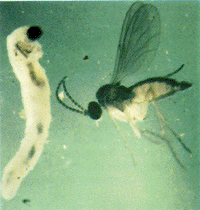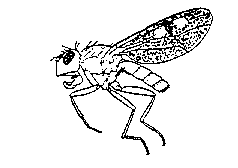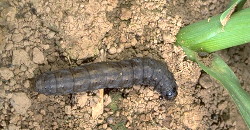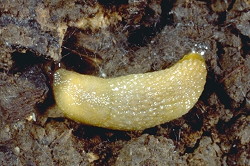Float Plant Pests
ENTFACT-114: Float Plant Pests | Download PDF
by Lee Townsend, Extension Entomologist
University of Kentucky College of Agriculture
FUNGUS GNATS, SHORE FLIES, AND BLOODWORMS

Fungus Gnat
Fungus gnats
Occasionally, fungus gnat larvae can be serious pests in greenhouses. Most are scavengers, feeding on decaying organic matter in the growing media. However, some species will feed on root hairs, enter the roots, or even attack the crown or stem of the plant.Infested plants generally lack vigor and may begin to wilt. Adults (gnats) can be seen running on the foliage before injury caused by the larvae becomes apparent.
Fungus gnats are small (1/8 inch) black flies with comparatively long legs and antennae, tiny heads, and one pair of clear wings. Females lay tiny ribbons of tiny yellowish white eggs in the growing media that hatch within 4 days. The clear larvae are legless and have black heads.
Larvae feed for about 14 days and pupate near the surface of the medium. Adults live only about a week. Under greenhouse conditions, about 20-25 days are required to complete a generation.

Fungus Gnat

Shore Fly
Shore Flies
Shore flies also are small gnats but have short antennae, red eyes, and heavier, darker bodies. A pair of smoky wings with several clear spots can be seen when looking closely at the insect.
They are good fliers and can be seen resting on most any surface in the greenhouse. They resemble winged aphids but aphids have two pairs of wings and the distinctive, tube-like cornicles on the abdomen, and do not move as quickly. The life cycle is similar to that of the fungus gnat. The yellow to brown larvae, which may be up to 1/4 inch long, differ in having no apparent head. Both larvae and adults feed mostly on algae growing on media, floors, benches, or pots. Some have been seen boring directly into the base of small plants. Damaged plants will easily break off at the soil surface. The adults may spread soil pathogens inside the greenhouse.

Bloodworm
Bloodworms
Bloodworms are the striking red "worms" that may be seen wriggling in float plant water. These long, cylindrical larvae are similar to fungus gnat larvae-- they are legless and have a distinct brown head.
The red color comes from hemoglobin, the same oxygen-carrying material present in our blood. The presence of hemoglobin allows this insect to develop in water with a very low oxygen content.
Bloodworms are common in stagnant water-- animal watering troughs and other accumulations of standing water. These insects are close relatives of the mosquito but the adults do not have sucking mouthparts and are not blood feeders. The larvae have chewing mouthparts and generally feed on algae or other organic matter in the water. They may be found in plant roots that grow through the bottoms of float trays but apparently do not cause significant injury. While fungus gnats and shore flies live in "very wet" situations, bloodworms generally live entirely in water. Elimination of standing puddles around the area and having a minimum amount of exposed water surface in the float bed will reduce the presence of these insects.
Because of their high moisture requirement, avoiding excessive watering to reduce moisture in growing media will help regulate these pests. Highly organic soils and potting mixtures containing peat are attractive to egg laying fungus gnats.
THRIPS
Thrips are slender, tiny insects about 1/25" long and range in color from light brown to black. They have 4 long, fringed wings that are held flat over the back. Thrips feed by rasping the plant surface and sucking up the exuding sap. Heavily infested leaves have a mottled or silvery appearance. Female thrips insert eggs into slits in the leaf. Eggs hatch in 2 to 7 days. Nymphs feed similar to adults and molt 4 times during development. They are inactive during the last nymphal stage prior to becoming an adult.
Winged adults are carried into the greenhouse on contaminated plant material or fly in during the summer and continue to breed throughout the winter. Prevention of infestations through the use of screens on ventilators, inspection of new material entering the greenhouse, and weed control in the greenhouse will help to manage thrips.
Several species occur in greenhouses. Thrips attack a wide range of plants in the greenhouse, highly susceptible hosts include azalea, calla lily, croton, cyclamen, cucumber, fuchsia, ivy, and rose. Various thrips species also transmit plant diseases. The most serious are the western flower thrips and onion thrips, which are vectors of tomato spotted wilt virus or impatiens necrotic spot virus. This virus attacks a wide variety of plants.

Cutworm
CUTWORMS
All caterpillars are the immature stages of moths. They chew on leaves, stems, and fruits of many kinds of plants. Infestations may begin from moths entering through ventilators or by bringing infested plants into the greenhouse.
Cutworms can be serious pests of younger plants. They hide during the day in soil or mulch and feed on the plants at night. When monitoring for these insects look for cut plants or leaves with large sections removed.
The most common cutworm found on float plants early in the year is the variegated cutworm. About 1-1/2" long when full grown, it can completely destroy a large number of seedlings and small plants.

Slug
SLUGS
Slugs can become serious greenhouse pests. Slugs are fleshy, slimy animals that feed mainly at night. They prefer cool moist hiding places during the day. Slugs rasp on leaves, stems, flowers, and roots. They produce holes in the leaves or just scar the leaf surface. Small seedlings are especially vulnerable to these creatures. Silvery slime trails are evidence of infestations.
Sanitation is important for slug control. Keep the greenhouse free of plant debris (leaves, pulled weeds, etc.), old boards, bricks, or stones that provide cool moist hiding places for slugs. Metaldehyde bait pellets can be distributed beneath the benches in greenhouses for slug and snail control on ornamentals. Do not allow pellets to come in contact with plants.
Cultural Controls are Essential
Cultural controls are the primary defense against insect infestations. Good practices include:
- Keep doors, screens and ventilators in good repair.
- Use clean or sterile soils or ground media. Clean or sterilize tools, flats and other equipment.
- Maintain a clean, closely mowed area around the greenhouse to reduce invasion by pests that develop in weeds outdoors.
- Eliminate pools of standing water on floors. Algal and moss growth in these areas can be sources of fungus gnat and shore fly problems.
- Dispose of trash, boards and old plant debris in the area.
- Remove all plants and any plant debris, clean the greenhouse thoroughly after each production cycle.
- If possible, allow greenhouse to freeze in winter to eliminate tender insects like whiteflies.
- Avoid over watering and promote good ventilation to minimize wet areas conducive to fly breeding.
- Avoid wearing yellow clothing which are attractive to many insect pests.
- Maintain a weed-free greenhouse at all times.
Chemical Control
Orthene 75S is labeled for use in greenhouses and tobacco float systems for control of several insect pests. The product, applied to the foliage, should kill these flies. Impact on the larval stages will be minimal. Therefore, cultural controls are needed in advance to minimize the potential for infestation.
Revised: 1/94
CAUTION! Pesticide recommendations in this publication are registered for use in Kentucky, USA ONLY! The use of some products may not be legal in your state or country. Please check with your local county agent or regulatory official before using any pesticide mentioned in this publication.
Of course, ALWAYS READ AND FOLLOW LABEL DIRECTIONS FOR SAFE USE OF ANY PESTICIDE!
Photos courtesy Ric Bessin, University of Kentucky Entomology
